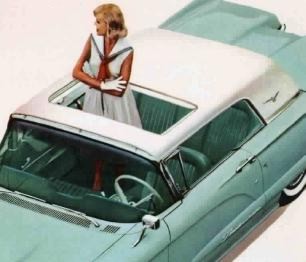|
Production Numbers
|
|||
1960 |
|||
|
TOTAL PRODUCTION
63A - Hardtop 76A - Convertible 63A - Hardtop with Sun Roof |
92,843
78,447 ($3,755) 11,860 ($4,222) 2,536* ($3,967) |

1960 THUNDERBIRD:
HIGHEST PRODUCTION RECORD FROM 1955-1976 |
|
|
INTRODUCTION DATE
Production Started Production Ended |
October 8, 1959
September 8, 1959 September 9, 1960** |
||
|
*Production figures for 1960 do not break out production of the Hardtop
with Sun Roof. The only way to verify a car left the factory with the Sun
Roof is to locate the original ROT or build sheet, which would indicate
a code of "5" in the TOP section. We have provided separate production
figures here to clear up a myth that has circulated for years about the
existence of a Special Edition Gold Roof Hardtop. (See story below.) For
the record, a total of 80,983 Thunderbird Hardtops were made during the
year, including two stainless steel cars [link opens in new window] built for Allegheny Ludlum Steel Corporation.
**Thunderbirds were scheduled to be built through Tuesday, September 13th, 1960, but the assembly line was running ahead of schedule, and the last Thunderbirds actually came off the line on Friday, September 9, 1960. The data plates on cars built the last day would still show a date code of 13W due to the fact these plates are made ahead of time, and new plates normally weren't produced for minor changes. |
|||
|
Over the years, Ford has come out with a few exceptional limited or special
edition Thunderbirds. These include the 1963 Limited Edition Landau and the 1965 Special Landau, in particular. None, however, are as special or rare as the "Gold
Edition" Hardtops from 1960.
"Why?" you may ask. Well, for one, they DON'T EXIST! That makes them extremely rare! It seems that Golde and Company, of West Germany, held a patent on a sliding roof system for automobiles. Several different styles were available, including a power-operated one that opened and closed at the touch of a button. These were offered through various car dealers around the world, giving new car owners a way to customize their car and have a fresh air feature without buying a convertible. As planning progressed on the 1960 Thunderbird, Ford was looking for something unique for the car, and after executives had the opportunity to ride in a 1959 Thunderbird prototype with the sun roof feature, it was approved for 1960 production. The story goes that Ford was approached by Golde and Company in 1957 regarding their sun roof feature. Golde had opened a new office in Detroit with the intention of having the American automobile manufacturers offer their sun roof. Ford was interested, and during the Fall of 1957 and Winter of 1958, Ford engineers adapted hardware for the sun roof that would work with the Thunderbird roof structure. Mockups were made and by January 1959 a working sun roof prototype unit had been fitted to a 1959 Thunderbird Hardtop. William Clay Ford, Product Planner Donald Petersen, and Thunderbird Stylist Bill Boyer met at the Dearborn Test Track on a frigid January day for a test drive in the prototype car. Milton Katz, an Engineer for the Budd Company, who built T-bird bodies for Ford, was familiar with the Golde sun roof, as he had been offered a job on Ford's engineering team for this project. Katz came along for the ride to answer any technical questions that might come up. The biggest concern was wind noise and turbulence inside the car. The Thunderbird was Ford's flagship automobile, so such things could not be permitted. Thus the 1960 Thunderbird Hardtop with Sun Roof became on official model. It seems that insiders at both Budd and Ford referred to the option as the "Golde top", or "Golde roof", hence the confusion with the name. The fact is, the Hardtop with Sun Roof was the only Golde Thunderbird model made. There are no separate special edition cars with gold painted roofs. So, if you have a "Gold Edition" 1960 Thunderbird, hopefully it has a hole in the roof, and not a gold painted top! There have been occasions for disagreement about the actual production numbers for the 1960 Thunderbirds. It has been officially reported that 2,536 "Gold Top" models were produced, and at the same time, other sources report that approximately 2,500 Sun Roof models were also made. The error in figures between the two is usually 36 units. Perhaps the confusion about the real numbers is also due to the misunderstanding of the Sun Roof/Gold Top cars. Automotive Mileposts believes the correct production figure for this option is 2,536. Additional information: The History of Golde Sunroof/American Sunroof Corporation (ASC) Related: Thunderbird Sunroof Registry |
|||
 Shown above, the new for 1960 Thunderbird Hardtop with Sun Roof, also known as the "Gold/Golde Edition" Hardtop. Body is Aquamarine (code C), with a Corinthian White roof (code M), and a Turquoise Leather (code 87) interior. Note the "Delta-Wing" mirror in the photo. After 1960, a factory installed sunroof would not be offered for the Thunderbird again until 1969. |
|||
|
|
|||